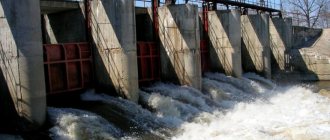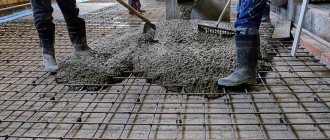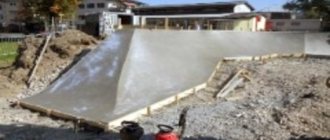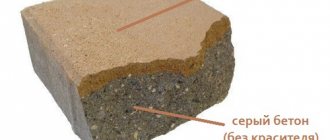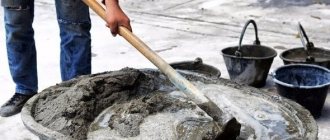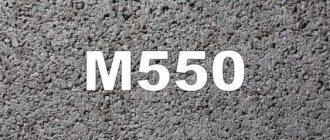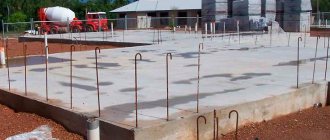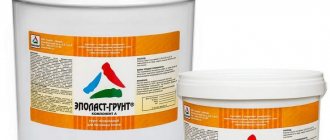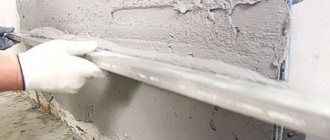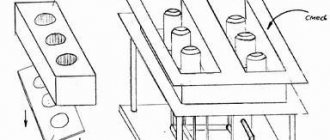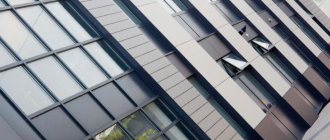Comments:
Rating: 34
Heat-resistant concrete is a type of concrete that is used under conditions of long-term exposure to high temperatures and is able to retain its mechanical properties. It is used in industry in the construction of thermal units, foundations of blast furnaces, recycling furnaces, brick firing.
Characteristics of concrete.
In small enterprises and private construction, heat-resistant concrete is used to construct prefabricated block heating stoves, fireplaces, stoves in baths and saunas, and chimneys.
Due to its low thermal conductivity, ordinary concrete is able to withstand short-term heating up to a temperature of 200°C, but when the temperature rises to 200°C - 250°C, it loses up to 25% of its strength, and at temperatures above 250°C it begins to crack, bonds with reinforcement and it is completely destroyed.
The main reason is that at high temperatures it dehydrates and decomposes its components.
Due to moisture and sudden temperature changes when extinguishing fires, ordinary concrete breaks down even faster.
Heat-resistant concrete can be used at temperatures not exceeding 1580°C, refractory concrete - up to 1770°C, highly refractory concrete - above 770°C. The main binding materials for their production are Portland slag cement, Portland cement, phosphate additives, orthophosphoric acid, and liquid glass.
To give it such properties, refractory rocks and refractory crushed aggregates (crushed products made from refractory materials) are added to the mixture. Heat-resistant concrete becomes more durable during operation.
How to make heat-resistant concrete with your own hands
List of concrete grades.
There are two main ways to make heat-resistant concrete with your own hands: use individual components or a ready-made dry mixture.
The second option is preferable.
The factory-made mixture is homogeneous and meets the standards. Just add water to it and mix thoroughly. After it hardens, high quality refractory concrete is obtained.
If you prepare the mixture yourself, you need to choose the right type of materials depending on the conditions under which the concrete will be used:
- if frequent interaction with water is expected, liquid glass cannot be added to the mixture; if the environment is acidic and aggressive, Portland cement cannot be used.
An acidic environment is formed in chimneys. Sulfuric anhydride contained in combustion products destroys concrete made from Portland cement.
If calcium aluminates and silicates are added to liquid glass, the result is concrete with increased resistance to aggressive environments. It gains strength faster, has excellent water resistance and can be used at temperatures up to 1600°C.
At home, existing available materials can serve as filler: refractory rocks, chromite ore, basalt, diabase, andesite, broken clay, high-alumina, fireclay, talc, magnesite and ordinary bricks. Dunite, titanium-alumina slag, is used.
To prepare porous concrete, blast furnace slag, expanded clay, and expanded perlite are used.
At home, the material should be crushed to sizes of 5-25 mm. Crushing is the longest and most difficult process. After this, the filler should be dried.
The size of fractions in factory mixtures is 0.1-5 mm. The more homogeneous the fractions, the higher the quality of the concrete.
To improve the properties, finely ground additives are added to the mixture: pumice, cement.
At normal humidity and air temperature of 20°C, the mixture hardens within 24 hours.
Return to contents
Scheme for preparing a concrete mixture.
When purchasing an industrial mixture, you need to consider several recommendations.
The finished dry mixture has a limited shelf life.
For individual use, you need to purchase a coarse-grained mixture with a high density.
The composition of mixtures from different manufacturers may differ; you should carefully study the instructions on the packaging. Typically, the package weighs 22-25 kg; 7-8 liters of water are required to prepare the solution. It is preferable to use less water, since its excess increases the hardening time and worsens the properties of concrete.
For high-quality preparation of the mixture, even in small volumes, you should use a concrete mixer. Water is poured into it and, with constant stirring, the dry mixture is added until a homogeneous mass of the required thickness is obtained. If necessary, plasticizers can be added.
Of the available fillers, you need to use one type. Different materials have different coefficients of thermal expansion, and concrete made from different types of aggregates can crack over time.
If there is a structure made of ordinary concrete, its resistance to high temperatures can be increased by treating it with special impregnations or mastics. Penetrating into the structure, they reduce the degree of dehydration and dehydration.
Concrete is heat-resistant, manufactured in compliance with technological standards and from correctly selected components. will reliably serve for decades, ensure structural reliability and fire safety.
The need to use fire-resistant materials quite often arises during the construction of facilities.
In the future, this allows you to protect structures and people from the unpleasant consequences of accidental fires. One of these materials is heat-resistant concrete, which can withstand high temperatures up to 1000 °C. At the same time, it retains its beneficial qualities and does not lose its shape.
General information: materials and characteristics of heat-resistant concrete
Heat-resistant concrete is a special type of concrete material that can withstand temperatures in the range of +1580-1770C for a long time without loss of operational and mechanical properties (refractory concrete, in turn, can withstand short-term heating up to a maximum temperature of +200C).
Concrete is used in the construction of residential and industrial buildings. Fire-resistant and heat-resistant concrete is used to make barbecues, home heating stoves, saunas, baths, chimneys, fireplaces, etc.
Heat-resistant concrete can be structural and thermal insulating. The structure is light porous, dense, cellular.
Composition of dense fire-resistant mortars
Dense heavy heat-resistant concrete (the composition may be different) is usually used in the creation of fire-resistant structures, as well as in the form of heat-resistant lining in certain thermal units: in the chemical industry, blast furnace recuperators, in special brick kilns, in the process of building chimneys pipes
Knitting
Heat-resistant concrete is produced in accordance with GOST 20910 90. This document assumes the possibility of using various binders in the preparation of the solution.
Types of binders for production:
- Liquid glass
- Aluminous (this can also include high-alumina) cement
- Portland slag cement with special microfillers
- Portland cement with the obligatory inclusion of a microfiller (finely ground additive) in the composition
In a neutral/alkaline environment, a mixture of Portland slag cement and Portland cement is usually used. Liquid glass is suitable for acidic gas environments. For hydrogen, phosphorus, and carbon environments, it is better to choose alumina and high-alumina cements.
Fillers
Refractory concrete involves the introduction of not only special binders, but also the right fillers, which must expand evenly and thus withstand the effects of fire and high temperatures. Ordinary fillers guarantee resistance at a maximum of +200C, then they become less durable and at +600C they are completely deformed.
When refractory concrete is prepared, the composition involves the use of a material as fillers that will not collapse/soften at high temperatures, and will not cause high stresses to appear in the internal structure of the monolith.
Selecting aggregate according to temperature:
- +600 – 800С: rocks (diabase, andesite, basalt), porous materials from volcanic rocks, this can be granulated blast furnace slag, broken bricks, artificial porous structures (expanded perlite, expanded clay, slag pumice is suitable, etc.) .
- +1200 – 1700С: crushed refractory materials are added – chromite, fireclay brick, magnesite, corundum and burnt kaolin are often chosen.
- It is possible to add special materials obtained by firing at a high temperature a mixture of refractory clay and magnesite - aluminosilicates, which are characterized by minimal deformation and good fire resistance.
Technical requirements
The grade of fire-resistant concrete should include the following parameters:
- Type of concrete: heat-resistant is indicated by the letters BR
- Binder: aluminate (A), Portland cement (P), silicates (S)
- Compressive/tensile strength class – B1-B40
- Operating temperature – IZ-I18
As for density, a material with an index of 1100 kg/m3 is used as thermal insulation for unloaded enclosing structures, >1400 - for the construction of enclosing load-bearing structures of public/residential buildings. According to the level of maximum temperature, concrete can belong to one of 18 classes: I13-I18 are used only for non-load-bearing structures.
If the density of concrete is 1500 kg/m3, it must have a water resistance in the W-W8 range. Frost resistance is at the level of F-F75. Residual strength and deformation temperature indicator under mechanical load directly depend on the type of binders and the exact heating temperature.
As for the strength class, for stressed heat-resistant structures the indicator should be at least B30, without load - a minimum of B12.5 is allowed.
Classification
There are several types of heat-resistant concrete, which is also called fire-resistant or heat-resistant.
The material contains special fire-resistant additives. The main binding component in the production of heat-resistant concrete is Portland cement. The following can be used as fillers: blast furnace slag, rock screenings (diabase, andesite, porous rocks of volcanic origin, diorite, artificial fillers), blast furnace slag.
The material is divided into separate classes according to:
- Structure (heavy, light, porous). Purpose (thermal insulation, structural). The nature of the fillers. The binder components used.
Specifications
Fire-resistant concrete prepared using Portland cement as a binder has a classic strength index. When conducting a compression test, the limit values are in the range from 200 to 600 MPa/cm2.
Manifestations of thermal stability are observed when temperatures reach no more than 500 °C. Prolonged exposure to an open flame or prolonged contact with hot surfaces significantly reduces the strength properties of cement and often causes defects.
The most fire-resistant concretes prepared on the basis of alumina are able to withstand any household temperatures.
Aluminous coatings saturated in composition are characterized by thermal stability of about 1600 °C and higher. A gradual increase in temperature leads in this case to an increase in heat resistance, since the cement mass is converted into a ceramic state. However, despite its high resistance to elevated temperatures, aluminous refractory concrete has relatively low strength. The material made using such components can withstand mechanical pressure of up to 25-35 MPa/cm2.
Areas of application
Primarily, refractory material is used in the manufacture of thermal structures, furnaces for industrial and domestic use, foundations, manifolds, and combustion chambers. However, it cannot be said that such concrete is used only in structures that are susceptible to thermal influences.
Thus, the specific composition of refractory concrete contributes to its widespread use in the chemical industry, in the production of building materials, and to meet the needs of the energy sector.
Heat-resistant material is used in the construction of floors, floating structures, and purlin bridges.
They give preference to this construction basis due to the need to lighten structures, taking into account high strength and reliability indicators. The refractory composition makes it possible to reduce the weight of structures by approximately 40%. This is explained by the use of a significant volume of porous fillers in the mixture.
Preparation of the composition
How to create fireproof concrete by making your own mixture? For this, water, binders and various heat-resistant fillers are used.
The manufacturing process has its own distinctive features. The components used must be of particular purity. In addition, clogging of refractory and refractory components with sand, limestone or granite is eliminated.
Making such mistakes in production technology often leads to rapid destruction of the material.
Additional technology recommendations
Refractory concrete, the composition of which is described in the article, may have a certain brand. Each variety involves the addition of its own plasticizer, magnesite powder and ferrochrome slag. If the goal is to prepare lightweight concrete, then you should use expanded materials of the following type:
- vermiculite;
- expanded clay;
- perlite.
If you decide to order the production of the mixture from a professional, then they will select the ratio of the components themselves, in accordance with your project. The composition is selected according to operating temperature and service conditions.
Manufacturing techniques
There are several ways to produce heat-resistant concrete with your own hands. First of all, you can obtain the material using a ready-made dry mixture, which has all the necessary components. A more complex option involves mixing the components yourself in the required proportions.
The optimal solution is to use the first method, since the best components are used in the production of heat-resistant mixtures in the factory. Moreover, in this case, the manufacturing technology is carefully followed.
As a result, the consumer gets the opportunity to use a ready-to-use mixture of the highest quality. It is enough just to add a solvent or water. When making it yourself, in order for the material to acquire fire-resistant properties, it is advisable to add the following finely ground components to the mixture: andesite, fireclay, chromite ore, magnesite cement. The result of the correct selection of ingredients and compliance with proportions is a material that can withstand elevated temperatures without collapsing.
Additional information about the composition by type of filler
If you decide to make refractory concrete with your own hands, then you can use different aggregates, namely:
- dinas;
- corundum;
- quartz;
- ready-made mixtures.
When considering concrete composition, it is necessary to distinguish grades. For example, ASBG is a refractory dry aluminum-containing mixture, which is used in non-ferrous and ferrous metallurgy, as well as thermal power engineering. A high-alumina concrete mixture with fire-resistant characteristics is designated by the abbreviation VGBS and is intended for creating a monolithic lining for steel-pouring ladles, walls and when constructing the bottom.
This composition can be operated at temperatures up to 1800 °C. The reinforcing dry high-alumina mixture is designated by the letters SSBA. It is intended for thermal units, furnaces, as well as the installation of a reinforcing layer. The impact temperature can reach 750 °C.
Tools and materials
By resorting to making refractory concrete yourself, you can significantly save money by refusing the services of craftsmen. However, before you start making the mixture, it is recommended to prepare the necessary tools and materials. Here you will need the following:
- equipment for mixing concrete components; shovel-trowel; wheelbarrow for transporting materials; shovel; water sprayer; wooden formwork, casting molds; sand, gravel, slaked lime, heat-resistant components; Portland cement.
Manufacturing Features
When producing refractory cement, pre-prepared dry components are placed in a concrete mixer (cement-sand ratio is 1:4). After forming a homogeneous mixture, water is added in the amount necessary to achieve a dough-like consistency. Since refractory building bases have specific viscosity characteristics and quickly harden by adding water, it is better to follow the recommendations of the cement manufacturer.
The finished mixture is distributed into molds, poured into formwork or used as a binding material when laying refractory bricks. When using aluminous fillers, after adding water they act extremely quickly, which avoids premature setting of the solution.
At the end of the work, it is recommended to thoroughly clean and wash the equipment. Scraping off the hardened refractory material from your tools over the next 24 hours will be an extremely difficult task.
If it is necessary to prepare small volumes of mortar using Portland cement, the components can be mixed manually. It is convenient to use wide containers for this - deep basins, bathtubs, troughs.
Today it is impossible to do without fire-resistant concrete. It is necessary when constructing fireplaces, stoves, baths, as well as when laying chimneys. In order for this material to perform its functions at a high level, it must contain only high-quality components.
In addition, strict adherence to proportions during manufacturing is necessary.
Only in this case will it be suitable for construction and will guarantee the safety of a particular structure. Today in construction markets you can find cellular, lightweight and dense heat-resistant concrete. The choice depends on the type of building and its purpose.
Cooking yourself
Diagram of a concrete mixer for preparing concrete.
Heat-resistant concrete can be prepared with your own hands, but then it must fulfill all the assigned tasks. Also, when working with heat-resistant concrete, you must follow the recommendations and adhere to the instructions, which, in turn, must comply with the requirements and technological standards. As a result of making a refractory component with your own hands, you should get concrete that, like the factory one, is resistant to temperature changes and has thermal insulation functions. When heated, it should not lose its properties and shape. Making your own heat-resistant concrete will reduce construction costs.
Currently reading: Characteristics of M400 concrete
When making heat-resistant material at home, you need to stock up on liquid glass, barium cement, and asbestos. These components will give concrete the characteristics that will allow the material to be used in the construction of structures with high temperature conditions.
To make a heat-resistant material with your own hands, you need to place cement and sand in a ratio of one to four in a concrete mixer. After thorough mixing, add water until the consistency is similar to dough. The resulting solution is poured into molds, and then into formwork. To remove any trapped air, sealants are used in the solution.
Return to contents
What should be included in heat-resistant concrete?
To create fireproof concrete yourself, you need to add liquid glass, alumina cement and asbestos to the composition. These additives are excellent for use in high temperature environments.
It is very important that all elements are of high quality, otherwise the building will quickly fall apart and it will be impossible to restore it. In order for heat-resistant concrete to serve for a long time and be of the highest quality, you need to use good binders. They may be:
- slag Portland cement; liquid glass; alumina cement; Portland cement; periclase cement.
Do-it-yourself heat-resistant concrete: stages of creation
If you know a little about construction and know how to properly prepare certain mixtures, it will not be difficult for you to make fireproof concrete yourself. Of course, this procedure can be entrusted to a professional, but in this case you will have to spend extra money that would be useful for other purposes. Those who are ready to prepare heat-resistant concrete with their own hands should know that they first need to stock up on the following devices and materials:
- slaked lime; gravel; sand; fire-resistant cement; plastic sheets; formwork; hose; shovel; sprayer; wheelbarrow; concrete mixer.
The concrete mixer and wheelbarrow should be placed in such a place that they are close to the water supply.
You will need a lot of water, so you need to take care of this in advance. Water will be needed to add to the mixture, to wash tools and, finally, to wash the site where the heat-resistant concrete was made. All materials must be mixed in a ratio of 3:2:2:0.5. The action plan is as follows:
First, you need to place sand and gravel in a concrete mixer. Next, slaked lime and refractory cement are added exactly in proportions. Then, using a shovel, you need to thoroughly mix all the components of the composition. Then you need to add water and mix again. The liquid must be poured until the concrete reaches the correct consistency.
You can check the composition by making a lump out of it. If you manage to do this, then you will no longer need water. If the composition spreads on your hands, you need to add a little more water.
Application of heat-resistant concrete
The composition of heat-resistant concrete includes special additives and mixtures that give the material significant strength when exposed to high temperatures.
During operation, refractory concrete becomes even more resistant to heat. A big advantage is the fact that heat-resistant concrete does not require expensive special firing, which is why it is widely used in construction.
According to the principle of operation, it does not differ from ordinary concrete and can guarantee complete safety and protection of your structure from overheating. In addition, refractory concrete can be used as a thermal insulation material.
Depending on the area of application, cellular, lightweight or dense concrete is divided.
A material is considered light when its dry weight is no more than 1500 kg/m3. To the base raw materials of slag Portland cement, Portland cement, aluminous cement or liquid glass, finely ground impurities are added, such as broken fireclay bricks, lump fireclay, pumice, broken magnesite bricks, andesite and others. Additives promote the hardening of refractory concrete and form its fire-resistant qualities.
Composition of refractory concrete
The composition of concrete refractory includes special ingredients that give the material heat-resistant qualities. A mixture of cements is used as a base; it can be found on sale under the following labels:
- ASBS (aluminosilicate);
- SSBA (fireproof dry concrete reinforcement mixture);
- SBC (with corundum components);
- SABT (technical butane-propane mixture);
- ШБ-Б (with fireclay);
- TIB (light heat-insulating concrete);
- VGBS (with an increased percentage of alumina components).
Crushed components are added to the cement mixture. Fillers are ground either to a powder consistency or to specific sizes. The composition of the refractory concrete solution may include the following ingredients:
- Plasticizers. It can be expanded clay, ferrochrome slag, vermiculite or perlite.
- Binders. Liquid glass or aluminous substances, aluminophosphates or Portland cement are often used.
- Fillers. The most in demand are: fireclay sand, blast furnace slag, magnesite, chromite ore dust, corundum, crushed stone or pumice.
Important! If you want to prepare the material yourself and are looking for recipes on how to make refractory concrete with your own hands, first of all you should decide what technological and operational parameters it should have in order to ensure the proper quality of a particular structure.
Refractory concrete with phosphate and silicate binders
There is so-called special refractory concrete. This is when, in addition to the alumina-cement binder, a silicate or phosphate base is added to its composition.
Phosphate bonded refractory concrete adheres better to other refractories, hardens faster and has higher strength compared to alumina cement concrete. The hardening agent is cement, talc, magnesium oxide. The filler is high-temperature materials: corundum, broken corundum and high-alumina refractories, chromites and chromium magnesites.
Refractory silicate-bonded concrete is used in acidic environments. To increase hardness, sodium silicate, sodium fluoride, and phosphates are added.
The filler is quartz sand and high-silica fireclay. Due to its increased resistance to acids, silicate-bonded refractory concrete is commonly used for chimneys in pickling baths, tanks, and pipe linings.
If you decide to build a barbecue from heat-resistant concrete, or light a fireplace stove in your house with your own hands, then in order to save money during construction, you can easily do it yourself. To do this, use a ready-made dry mixture or mix the ingredients using a special technology similar to the preparation of ordinary concrete.
Factory mixtures are manufactured to all standards and can guarantee product quality. When using the ready-made dry mixture, carefully read the instructions on the package and strictly follow them.
The technology for manufacturing heat-resistant concrete is divided into two types: if the structure will be exposed to moisture, do not add liquid glass; if the environment is acidic and aggressive, do not use Portland cement.
Determine the work area, make sure water is available and tools are clean.
Labeling and composition
Heat-resistant cement is produced in the following types, which differ in the markings applied to the packaging:
- ГЦ40-ГЦ60, which marks aluminous compounds used in the energy, fuel, and construction industries;
Refractory materials are used in the creation of monolithic structures, special mortars and dry mixtures
- VGTSI-VGTsIII, as well as VGTs 70-VGTs 75 are abbreviations for high-alumina cements, characterized by increased refractory parameters, which do not emit odors when heated.
The use of raw materials based on alumina, crushed to a powder state, ensures effective hardening of heat-resistant solutions. The acquisition of strength characteristics is due to the ceramic contact of cement particles. This distinguishes the mixture from traditional brands of cement, during hardening of which hydraulic adhesion of the components is ensured.
The material includes various components:
- Granulated slag with a volume of 50 to 90%.
- Special additives that provide resistance to elevated temperatures - from 5 to 40%.
- Various alkaline metal compounds – 5-20%.
If it is necessary to ensure the operating temperature of cement increased to 1.6 thousand degrees Celsius, it contains calcium aluminates with a concentration of more than 75%, which are slags of aluminothermic origin.
